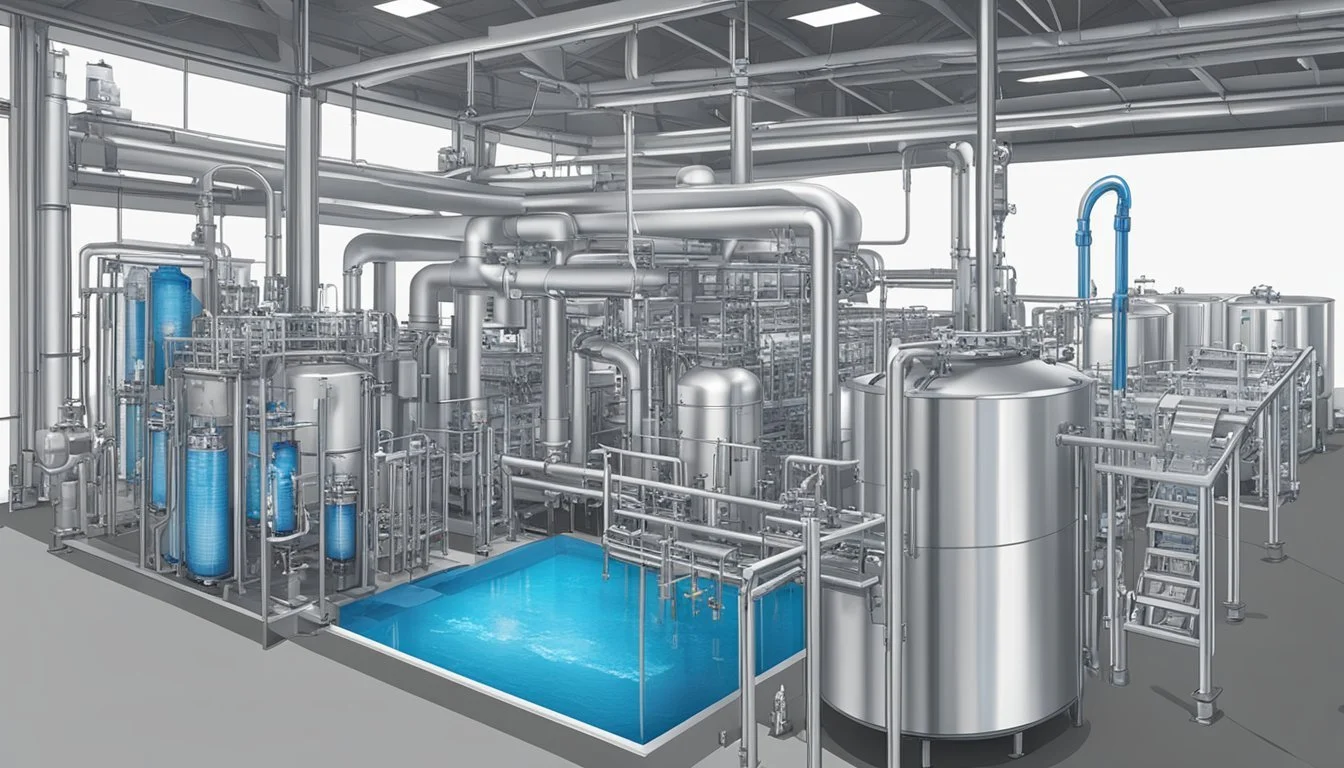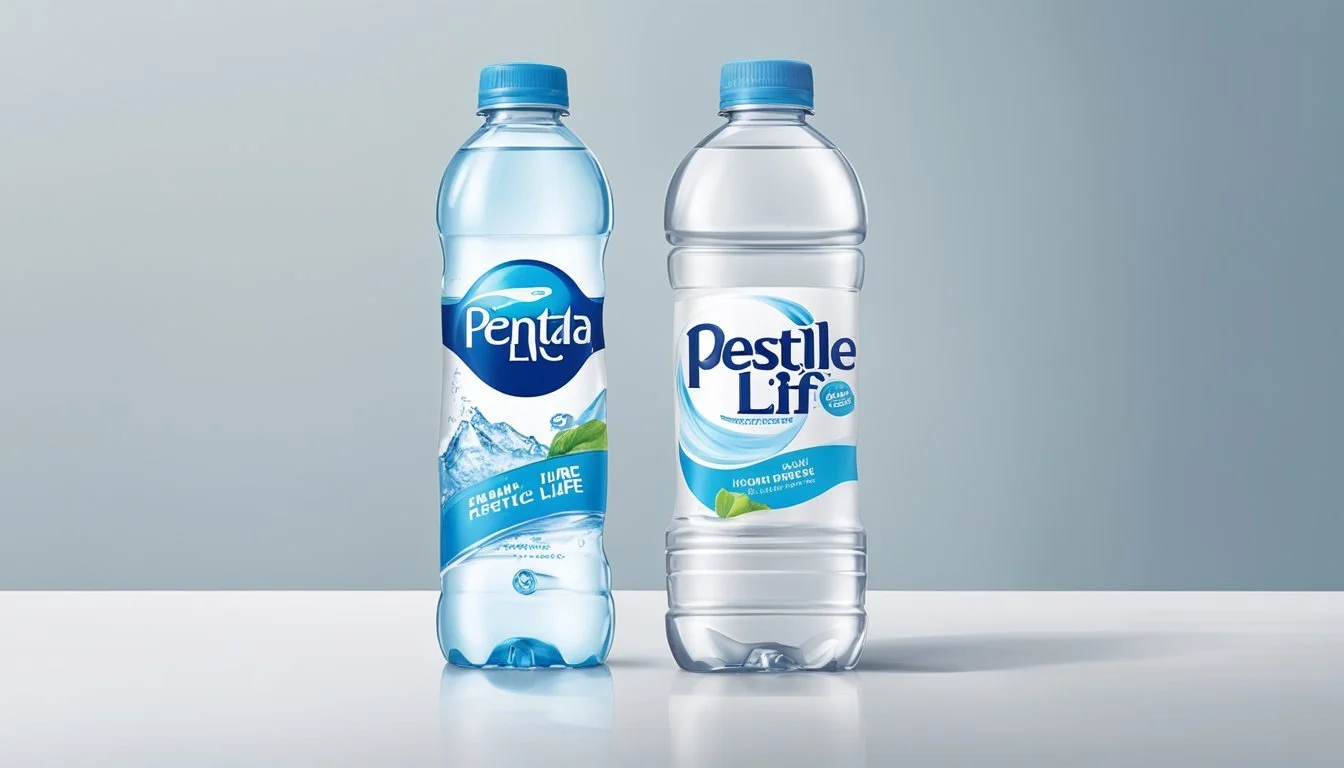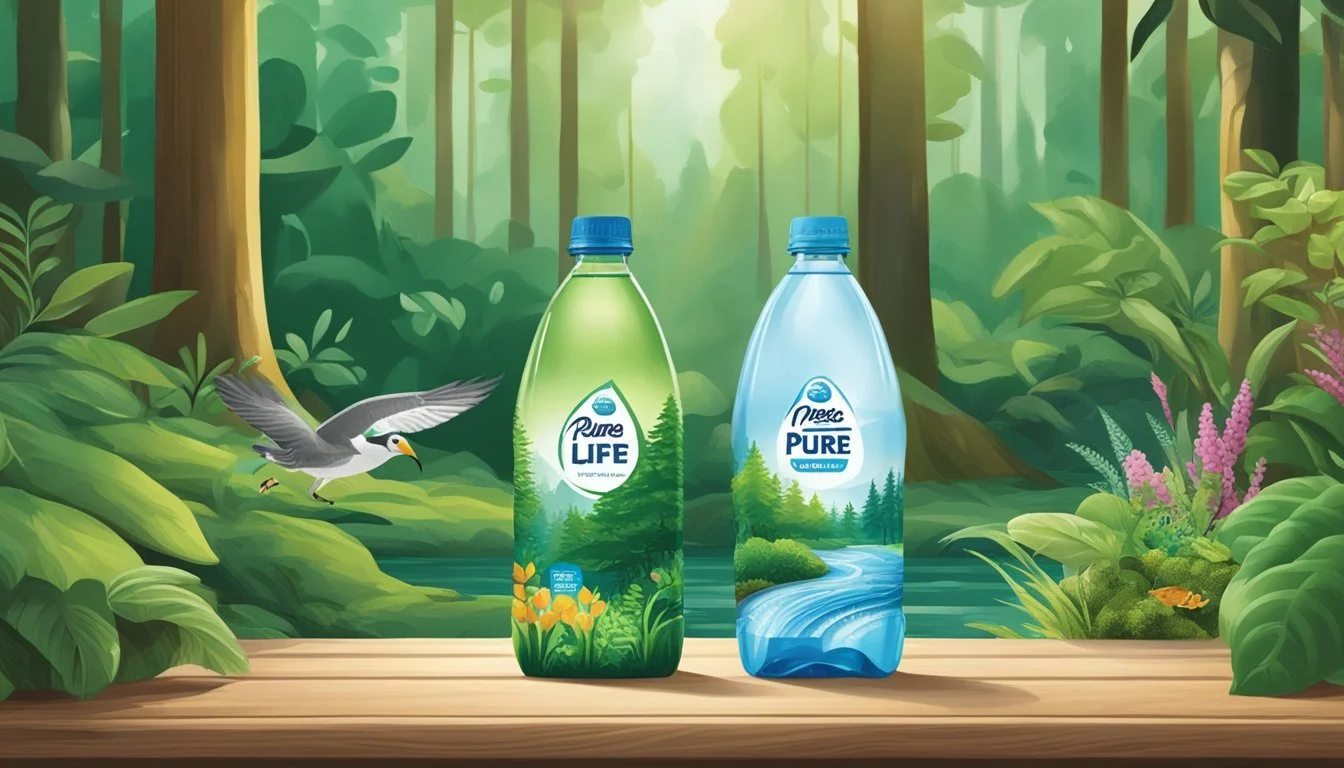Nestlé Pure Life vs. Penta
Comparing Quality and Taste in Bottled Water
When it comes to staying hydrated, consumers often turn to bottled water for its convenience and perceived purity. Among the myriad of brands available, Nestlé Pure Life and Penta stand out for different reasons. Nestlé Pure Life, which comes from the largest bottled water corporation in the world, offers widespread availability and a familiar taste. Despite its dominance in the market, the brand is often critiqued for being average, with its water containing added minerals for taste.
Contrastingly, Penta is not as ubiquitous as Nestlé Pure Life but prides itself on providing ultra-purified drinking water. Penta water undergoes a patented 13-step purification process, which includes infusing the water with oxygen. This meticulous purification method aims to deliver a clean and crisp taste, which appeals to those who are particularly discerning about the quality and taste of their water.
Choosing between these two brands often comes down to personal preference and priorities, be it the accessibility and price point offered by Nestlé Pure Life or the specialized purification process boasted by Penta. Each brand has carved a unique niche in the bottled water industry, catering to various consumer needs and preferences regarding hydration.
Brand Profiles
Within the bottled water market, Nestlé Pure Life and Penta Water stand as two notable brands. Each has unique characteristics and positions in the industry.
Nestlé Pure Life
Nestlé, the parent company of Nestlé Pure Life, is one of the world's largest food and beverage companies. Nestlé Pure Life is their primary bottled water product, boasting a global presence. The water for Nestlé Pure Life goes through a multi-step process of filtration, and the brand emphasizes its commitment to quality and sustainability. Despite its reach, the brand's reputation for taste and sourcing has been met with mixed reviews, placing it across spectrum ratings in the bottled water category.
Filtration Process: Rigorous, includes distillation or reverse osmosis
Market Position: Widely available, offering an affordable option in the global market
Environmental Initiatives: Various, including efforts to increase recyclability of bottles and reduce water usage in production
Penta Water
Penta Water is less ubiquitous than Nestlé but has its distinct niche. It's an ultra-purified drinking water that prides itself on its 13-step purification process, which includes UV light treatment and ozonation. The brand emphasizes purity and the absence of additives, catering to consumers who prioritize these factors in their bottled water choice.
Purification Process: 13-step, involves UV light and ozonation without added chemicals
Market Position: Marketed as a premium product, often at a higher price point than more common brands
Consumer Perception: Known for its high-level of purification and clean taste, albeit with a smaller market presence compared to Nestlé Pure Life
Both companies strive to serve different segments within the bottled water industry. Nestlé Pure Life aims for broad accessibility and affordability, while Penta Water positions itself as a premium brand focused on exceptional purity.
Water Sources and Collection
Understanding the origins of bottled water is crucial for consumers looking to make informed choices. The source of water for any brand can impact its taste, purity, and overall quality.
Nestlé Pure Life Source
Nestlé Pure Life's water is sourced from various places, including springs and wells. In some cases, water is drawn from municipal supplies before undergoing a rigorous purification process. This process is designed to maintain consistency in the taste and quality of the water across different regions. For instance, brands like Ice Mountain Natural Spring Water and Zephyrhills are part of Nestlé's family and are sourced from springs, reflecting in their labeling as spring water.
Penta Water Source
On the other hand, Penta Water prides itself on sourcing water from a single aquifer. Their water undergoes an 11-hour, 13-step purification process, which includes ultrafiltration, UV light treatment, and ozonation to achieve a distinct level of purity and cleanliness. Unlike Nestlé Pure Life, Penta does not source from municipal supplies, focusing solely on their aquifer for a consistent and controlled water source.
By offering insight into these practices, consumers can make choices aligned with their preferences for water sourcing and treatment.
Purification Processes
The purification of bottled water is critical in ensuring safety and taste. Both Nestlé Pure Life and Penta utilize advanced techniques, including reverse osmosis and multiple filtration stages, to purify their water.
Nestlé Pure Life Purification
Nestlé Pure Life's water goes through a rigorous 12-step purification process. The process includes the use of activated carbon filters, which remove large particles and chlorine, improving taste and odor. Reverse osmosis then removes dissolved inorganic solids by pushing water through a semipermeable membrane. Post reverse osmosis, Nestlé Pure Life adds minerals back into the water for taste before passing it through a final microfiltration step. This process not only purifies but also ensures a consistent flavor profile.
Penta Hydro-7 Purification
Penta's purification process, branded as Hydro-7™, includes seven steps designed to reduce substances like volatile organic compounds and heavy metals. Central to their method is a patented U.S. process involving deionization. After initial filtration, the water is subjected to reverse osmosis, followed by several stages of deionization. Penta does not add any chemicals or preservatives post purification, focusing on delivering water in its purest form. The absence of additives like sodium is a cornerstone of the brand's identity. Additionally, Penta uses ozonation in its final stage, which is a process that employs ozone for disinfection without leaving any harmful by-products.
Health Benefits and Concerns
When choosing between Nestlé Pure Life and Penta water, consumers should consider the health benefits and potential concerns associated with each brand, specifically in terms of hydration qualities and possible contaminants.
Hydration and Electrolytes
Nestlé Pure Life is known to have added minerals for taste. These minerals may include sodium, which can aid in hydration by replacing electrolytes lost during physical activity. The presence of electrolytes makes it a reasonable choice for maintaining hydration levels.
Penta water, on the other hand, undergoes a specialized purification process. While this results in a very pure water, the lack of natural minerals might not provide the same balance of electrolytes that one finds in spring water sources or brands that add minerals intentionally.
Contaminants and BPA
Contaminants in bottled water can be a concern for consumers. Nestlé Pure Life claims to have rigorous quality controls to keep their water free from harmful levels of contaminants. They emphasize their purification process, including reverse osmosis and demineralization.
Penta boasts an ultra-pure water with their 13-step purification process, which could result in lower levels of contaminants. The brand also highlights that their bottles do not contain BPA (bisphenol A), a chemical found in some plastics that can leach into the water and potentially cause health issues.
Both companies typically use plastic bottles, but the type of plastic and its potential to leach chemicals like BPA into the water varies. Nestlé has faced criticism over the environmental impact and potential health concerns of their bottled products, but has also committed to making their bottles BPA free. Consumers should look for the BPA-Free label on bottles for assurance.
Taste Profile
In considering the taste of bottled water, one must examine the various factors that influence flavor perception and recognize that consumer preferences widely vary.
Factors Affecting Water Taste
A key determinant in the taste of water is the level of dissolved solids. These minerals, such as calcium, magnesium, and sodium, impact the taste profile significantly. Nestlé Pure Life, sourced from various locations, generally undergoes a multi-step filtration process, which includes reverse osmosis and added minerals for a consistent taste. This can lead to a more predictable, albeit neutral, flavor profile.
Penta Water, on the other hand, claims to provide ultra-purified water with no additives or dissolved solids. Through this process, Penta Water is able to achieve pure H2O without the minerals that typically influence taste. This results in a clean and crisp taste that some consumers might find more refreshing.
It is noteworthy to mention that alkaline water, which has a higher pH level, is said to offer a smoother taste due to its alkaline mineral content. However, neither Nestlé Pure Life nor Penta is specifically marketed as alkaline water, and their taste profiles are thus not directly affected by a higher pH level.
Consumer Preferences
When it comes to bottled water, taste preferences are subjective and highly individual. Some people may prefer a neutral taste, which they equate with purity, often choosing brands like Nestlé Pure Life. This brand provides a consistent product that meets the expectations of a broad consumer base.
Others may lean towards a water with as few impurities as possible, such as Penta Water, which prides itself on removing more impurities than other leading brands.
Preference Factors Nestlé Pure Life Penta Water Mineral Content Added after filtration for consistent taste Virtually none Purification Multi-step filtration, including reverse osmosis Ultra-purified using a patented process Taste Perception Neutral, predictable flavor Clean, crisp taste
Ultimately, consumers choose based on personal taste, making it challenging to universally declare one brand of water as 'better' based on taste alone.
Environmental Impact
In assessing the environmental impact of bottled water brands like Nestlé Pure Life and Penta, specific focus on their packaging practices and overarching sustainability commitments provides insight into their ecological footprint.
Packaging and Plastic Use
Nestlé Pure Life utilizes single-use plastic bottles, which are widely recognized as a significant source of environmental pollution. While these bottles are lightweight and cheap to produce, they contribute to the ever-growing concern over plastic waste. Despite efforts to encourage recycling, a large percentage of these plastic water bottles end up in landfills or as litter.
Penta's packaging also primarily consists of plastic water bottles, indicating a similar environmental challenge. However, the extent to which Penta leverages recycled materials in its packaging, if at all, may set it apart in terms of environmental stewardship within the context of single-use products.
Sustainability Efforts
Nestlé has publicly committed to various sustainability efforts, aiming to improve their ecological impact. These include pledges to reduce the use of new plastics by increasing the recycled content in their bottles and investing in community recycling initiatives. Their efforts are critical given the Environmental Working Group's concerns over the environmental impacts of bottled water brands.
Penta's sustainability efforts, while not as publicly documented, are essential in evaluating its environmental considerations. For brands like Penta, transparency in reporting specific sustainability initiatives would help consumers make more informed choices.
Both brands face the challenge of addressing the Environmental Working Group's critiques regarding the environmental implications of plastic water bottles. Their commitment to sustainability and the effectiveness of their efforts remain pivotal in reducing their environmental impact.
Regulatory Compliance and Quality Reports
In the realm of bottled water, the compliance with regulatory standards and the availability of comprehensive quality reports are pivotal for consumer assurance. This section explores the adherence of Nestlé Pure Life and Penta to regulatory guidelines, including specifics on water quality reports and the application of EPA and FDA standards.
EPA and FDA Standards
Nestlé Pure Life and Penta both must comply with rigorous safety standards set by the Environmental Protection Agency (EPA) and the Food and Drug Administration (FDA). The EPA oversees tap water while the FDA regulates bottled water, ensuring it is safe to drink and free from contaminants. The FDA's regulations for bottled water include specific standards for various potential contaminants and are in some instances, such as lead, even stricter than EPA's standards for tap water.
Nestlé Pure Life:
Complies with FDA regulations which are nearly identical to EPA standards for contaminants, except for lead where the FDA's limit is three times stricter.
Maintains a pH level within the FDA's acceptable range, ensuring the water is not too acidic or alkaline for safe consumption.
Penta:
Adheres to FDA regulatory requirements, offering ultra-purified water that meets strict criteria for contaminants.
Utilizes advanced purification processes to conform to FDA standards, focusing on maintaining optimal pH levels for consumption.
Public Quality Reports
Transparency in water quality is provided by both brands through public quality reports which detail the source of the water and the treatment methods employed.
Nestlé Pure Life:
Offers detailed public quality reports accessible online, which include information on the water source and purification processes.
Earns high marks for clearly labeling the location of its water source and describing its treatment methods on the label.
Penta:
Provides comprehensive water quality reports, which consumers can readily access to understand more about their water's purity and origination.
Achieves high ratings for its commitment to transparency in water quality reporting and its advanced purification process.
Summary tables or PDFs of water quality by both brands can typically be found on their respective websites, offering consumers insightful data about the water they are purchasing.
Market Presence and Consumer Demand
The consumer landscape for bottled water showcases a clear demand for healthy hydration options, leading to significant market presence for big brands like Nestlé Pure Life and Penta. These brands are assessed not only on their water quality but also on their availability and customer reach.
Brand Popularity
Nestlé Pure Life stands as one of the world's most widely recognized bottled water brands, benefiting from the marketing heft and extensive distribution networks of its parent company, Nestlé. Despite this, consumer reviews often place it as average, indicating that reputation alone does not dictate consumer preference.
On the other hand, Penta may not match Nestlé Pure Life's level of global recognition. However, it has carved a niche for itself among health-conscious consumers who prioritize the purity and enhancement process of their bottled water, increasing its popularity in select markets.
Sales and Distribution
Nestlé Pure Life:
Region Distribution Channels Notes Global Supermarkets, Convenience Stores, Online Retailers Known for its market saturation
With its vast international network, Nestlé Pure Life's sales stretch globally, predominantly sold in supermarkets, convenience stores, and through online retailers, ensuring the brand's availability to a diverse and broad customer base.
Penta:
Region Distribution Channels Notes Select Markets Health Food Stores, Online Focused on quality-conscious consumers
Penta's distribution leans towards specialized channels such as health food stores and online platforms, targeting a specific segment of the market and often resulting in a more focused yet smaller scale of sales compared to Nestlé Pure Life.
Comparative Analysis
This section offers a detailed evaluation of Nestlé Pure Life and Penta Water, looking at their characteristics and market position relative to other bottled water options.
Nestlé Pure Life vs. Penta
Nestlé Pure Life, a product of the world's largest bottled water company, offers wide availability but is often considered average in taste and purity. In contrast, Penta Ultra-Purified Water claims a higher purification level, boasting a 13-step process that includes UV light, filtration, and reverse osmosis for purity and taste.
Purification: Penta utilizes a comprehensive multi-step process, potentially offering purer water compared to Nestlé Pure Life.
Taste: While taste is subjective, Nestlé Pure Life is reported as average, whereas Penta aims for a crisp and clean taste profile.
Competitors and Alternatives
The bottled water market is competitive with numerous brands vying for the title of the best bottled water. Here's how Nestlé Pure Life and Penta compare to other popular options:
Fiji Natural Artesian Water: Known for its soft mouthfeel and unique mineral profile provided by its volcanic source.
Evian Natural Spring Water: Offers naturally occurring electrolytes and minerals from the French Alps.
Aquafina Water: PepsiCo's answer to bottled water, Aquafina is widely available and known for its purification process.
When evaluating the best water brands, consumers often consider factors like source, taste, and purity. While Fiji and Evian are reputable for their natural sources, Penta's advanced purification processes set it apart, and Aquafina's wide distribution network makes it a formidable competitor in the market.
Consumer Resources
In analyzing and comparing bottled water brands like Nestlé Pure Life and Penta, consumers have resources at their disposal to make informed decisions. Two key tools are understanding how to read water labels and knowing how to find and use contact information for further support.
Reading Water Labels
Consumers should pay close attention to the labels on bottled water to understand what they are purchasing. Labels can provide information on the source of the water, such as whether it's from a spring, a well, or a municipal supply, which may be referred to as Calistoga in some regional brands. Additionally, the label might list mineral content and whether the water has undergone processes like reverse osmosis. For health reasons, it's also beneficial to check for the presence of any added ingredients, such as sodium or other minerals.
Contact Information and Support
Should consumers need more details or have concerns about their bottled water, contact information is crucial. Bottled water companies typically provide a phone number or email address on the label or their website. For example, Nestlé Pure Life and Penta might offer a customer support line for direct inquiries. In an age where digital communication is prevalent, some companies might also have a signal for real-time customer service chat. Here's a structure consumers might find for contact information:
Method Description Example Phone A dedicated customer support line for calls. 1-800-XXX-XXXX Email Direct email support for queries and concerns. support@example.com Chat / Signal Real-time support through chat platforms. Available on the website
Through these resources, consumers can gather all necessary information to compare bottled water options like Nestlé Pure Life and Penta effectively.







